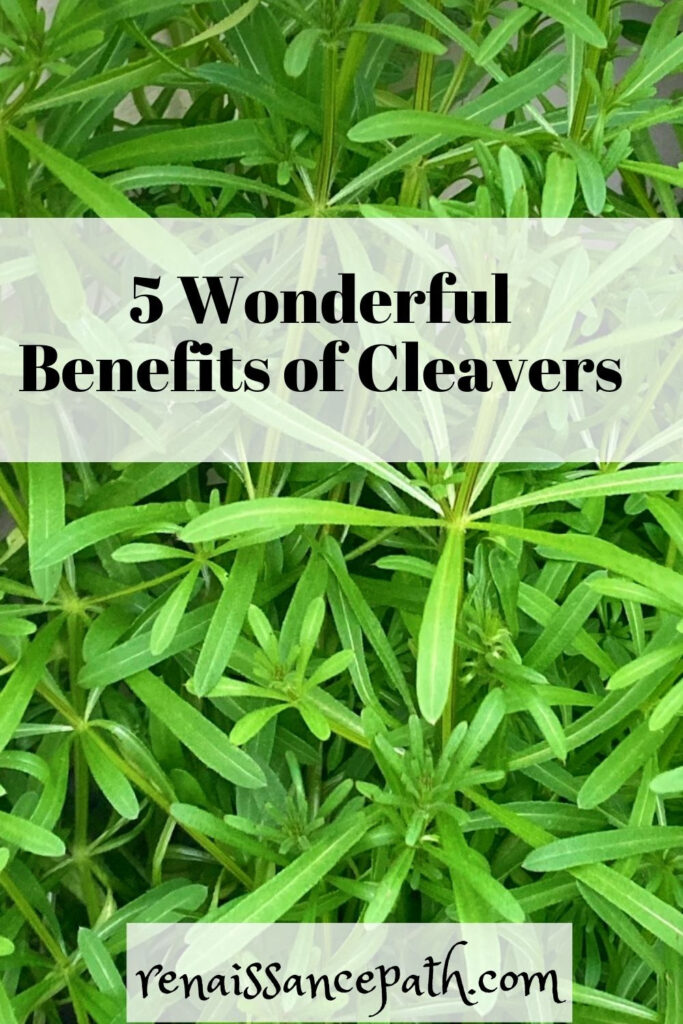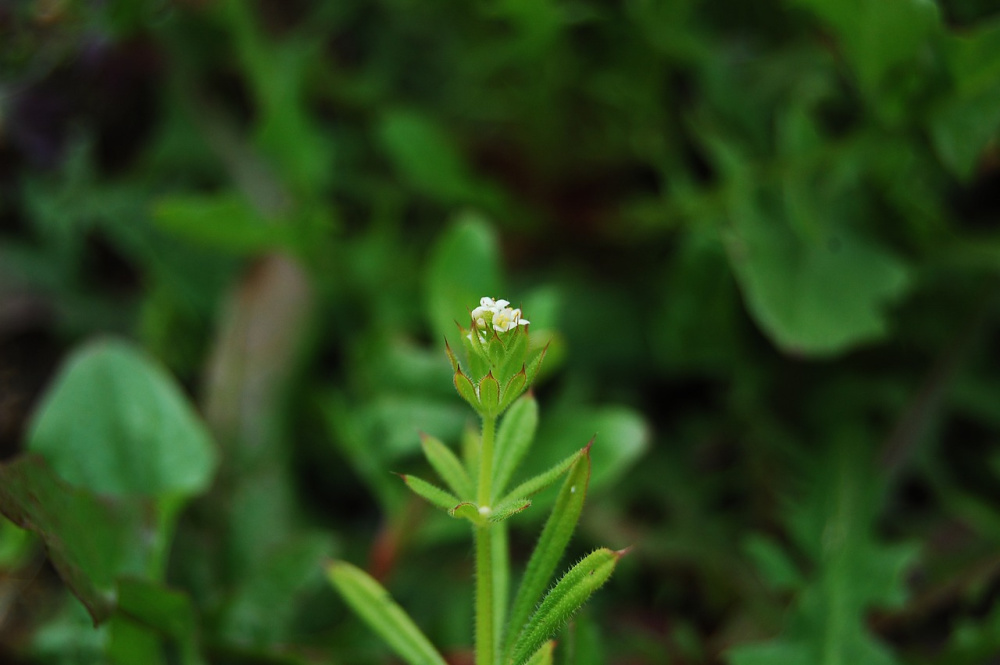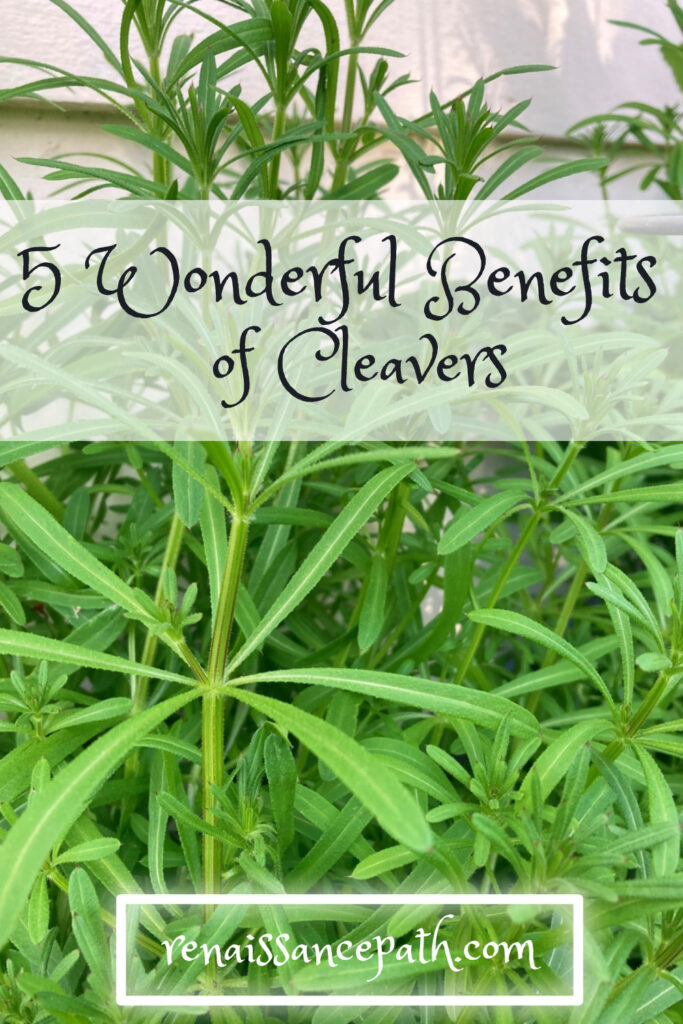Some of the links on this page contain affiliate links. Renaissance Path is a participant in the Amazon Associates Program, an affiliate advertising program that provides a way for websites to earn advertising fees by linking to products. We only link to products we normally use and trust. When you purchase an item through the link we receive a small commission at no additional cost to you. This helps pay for the costs associated with running this blog. Your support is greatly appreciated. Thank You!

5 Wonderful Benefits of Cleavers
Chances are you have encountered cleavers in your childhood and didn’t even know it. Growing up we just called it sticky plant, because if we walked past the plant it stuck to us. We also made cleavers crowns and bracelets. I also remember that once cleavers would go to seed we would have their sticky ball-shaped burs stuck to our pants and shoes. They reminded me of velcro balls.
As an adult, I started noticing this herbal ally growing in my flower beds, and on our compost pile. Being the curious plant lover that I am I was curious if it was edible and also if it had any medicinal value. And I found it certainly does have medicinal value.
Cleavers Info
Cleavers (Galium aparine) is an annual herbaceous plant belonging to the Rubiaceae family.
Cleavers are traditionally used for the lymphatic system and the kidneys and urinary systems. It’s great for detoxing and cleansing the water systems in your body.
Cleavers are found in temperate climates such as Asia, Northern Africa, Europe, and North America.
Cleavers have square or angular stems, the leaves come out in whorls. The whorl of leaves is in a star-like pattern. Each whorl has 6-8 leaves. The stems and leaves have tiny sticky hairs that actually have tiny hooks at the end, this is what allows them to stick to other plants, humans, etc. They have tiny white flowers at the tip of the stem. Cleavers are usually under 3 feet but can grow larger if they have something to attach themselves to like another bush or tree.
Other names Cleavers is known by.
Scarthgrass
Stickywilly
Velcro plant
Goosegrass
Bedstraw
Cleaverwort
Clivers
Catchweed
Gripgrass
Stickyweed

Cleavers Constituents
Cleavers contain tannins, alkaloids, anthraquinones, coumarins, iridoids, asperuloside, flavonoids, saponins, and alkanes.
These compounds possess anti-bacterial, anti-inflammatory, anti-cancer, and hepatoprotective, antispasmodic effects.
History of Cleavers
Cleavers earned their name from the old English word “To cling to”.
Cleavers have a long history. It’s believed that cleavers were even used in the manger where Mary gave birth to Jesus.
Cleavers are also called bedstraw as they were used as mattress stuffing.
Women in ancient times would give birth on cleavers because the plant mats together so well.
It was used to create a sieve to filter debris and hair from milk, in fact, the process is still used in parts of the world.
In the 1800’s Cleavers were used for skin infections and boils and were thought to have a cooling effect.
How to Use Cleavers
Cleavers is considered to be a tonic herb. Tonic herbs are herbs that nourish, tone, and restore the body and can be consumed daily for long periods of time.
You can make a cleavers tincture by filling a glass jar with fresh green cleavers and pouring 80 proof vodka over the top and placing the lid on and giving it a gentle shake to make sure all the plant material has been covered. Place in a cool dark room for 4-6 weeks then strain off plant material and toss. Rebottle tincture into amber glass tincture bottle. This will keep 3-5 years.
The seed pod burs can be used as a caffeine-free coffee substitute by roasting the seed pods once they turn a brown color and are mature. They just need to be roasted and then ground.
Cleavers is great to help flush out excess water weight. Maybe too much Chinese food last night? Drink some Cleavers tea. Use a couple of tablespoons of the fresh plant, pour hot water over, and steep for 5-10 minutes. You can drink it 3-5 times per day. Some herbalists say hot water can destroy some of the medicinal properties and that making a cold infusion is better. I haven’t seen data to support that one is better than the other. You can try both and see if there is a difference.
It can be used when there is a need to increase urination or inflammation of the bladder or urethra.

5 Wonderful Benefits of Cleavers
Helps remove debris and toxins from lymph nodes and blood.
It can be used as a poultice for boils. It also can help with bee stings.
Cleavers were shown to have remarkable immune-stimulating and scavenging activity(1).
Cleavers can help with water retention. It has diuretic properties.
Studies have shown cleavers to hepatoprotective(liver). Cleavers can be a great daily tonic to help stimulate bile and help a sluggish liver.
Harvesting Cleavers
The best time to harvest cleavers is when they start to flower in the late Spring. If you plan to make herbal medicine from this herb this is the ideal time when the medicinal properties are at their highest. Most herbalists agree that using cleavers fresh is the best.
Since Cleavers are so abundant most herbalists agree you don’t need to be concerned with overharvesting this plant. In some states, it is considered an invasive weed.

Supplies for making a Cleavers Tincture




I hope I have intrigued your interest in this stickyweed. Have you noticed cleavers growing nearby you? Have you ever made tea with it or made a tincture? Let me know in the comments.
Much Love,
Melissa
If you like learning about natural healing check out my post on Shepherd’s Purse.
[…] If you like learning about the healing properties of herbs check out my post here. […]